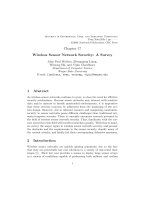Network Address Translation (NAT) potx
Bạn đang xem bản rút gọn của tài liệu. Xem và tải ngay bản đầy đủ của tài liệu tại đây (234.51 KB, 10 trang )
Network Address Translation (NAT)
CS-480b
Dick Steflik
Network Address Translation
•
RFC-1631
•
A short term solution to the problem of the
depletion of IP addresses
•
Long term solution is IP v6 (or whatever is finally
agreed on)
•
CIDR (Classless InterDomain Routing ) is a possible
short term solution
•
NAT is another
•
NAT is a way to conserve IP addresses
•
Hide a number of hosts behind a single IP address
•
Use:
•
10.0.0.0-10.255.255.255,
•
172.16.0.0-172.32.255.255 or
•
192.168.0.0-192.168.255.255 for local networks
Translation Modes
•
Dynamic Translation (IP Masquerading)
•
large number of internal users share a single external address
•
Static Translation
•
a block external addresses are translated to a same size block of
internal addresses
•
Load Balancing Translation
•
a single incoming IP address is distributed across a number of
internal servers
•
Network Redundancy Translation
•
multiple internet connections are attached to a NAT Firewall that it
chooses and uses based on bandwidth, congestion and availability.
Dynamic Translation (IP Masquerading )
•
Also called Network Address and Port Translation (NAPT)
•
Individual hosts inside the Firewall are identified based on of each
connection flowing through the firewall.
•
Since a connection doesn’t exist until an internal host requests a
connection through the firewall to an external host, and most Firewalls
only open ports only for the addressed host only that host can route back
into the internal network
•
IP Source routing could route back in; but, most Firewalls block
incoming source routed packets
•
NAT only prevents external hosts from making connections to internal
hosts.
•
Some protocols won’t work; protocols that rely on separate
connections back into the local network
•
Theoretical max of 2
16
connections, actual is much less
Static Translation
•
Map a range of external address to the same size block of internal
addresses
•
Firewall just does a simple translation of each address
•
Port forwarding - map a specific port to come through the Firewall
rather than all ports; useful to expose a specific service on the internal
network to the public network
Load Balancing
•
A firewall that will dynamically map a request to a pool of identical
clone machines
•
often done for really busy web sites
•
each clone must have a way to notify the Firewall of its current load so the
Fire wall can choose a target machine
•
or the firewall just uses a dispatching algorithm like round robin
•
Only works for stateless protocols (like HTTP)
Network Redundancy
•
Can be used to provide automatic fail-over of servers or load
balancing
•
Firewall is connected to multiple ISP with a masquerade for each ISP
and chooses which ISP to use based on client load
•
kind of like reverse load balancing
•
a dead ISP will be treated as a fully loaded one and the client will be
routed through another ISP
Problems with NAT
•
Can’t be used with:
•
protocols that require a separate back-channel
•
protocols that encrypt TCP headers
•
embed TCP address info
•
specifically use original IP for some security reason
Services that NAT has problems with
•
H.323, CUSeeMe, VDO Live – video teleconferencing applications
•
Xing – Requires a back channel
•
Rshell – used to execute command on remote Unix machine – back channel
•
IRC – Internet Relay Chat – requires a back channel
•
PPTP – Point-to-Point Tunneling Protocol
•
SQLNet2 – Oracle Database Networking Services
•
FTP – Must be RFC-1631 compliant to work
•
ICMP – sometimes embeds the packed address info in the ICMP message
•
IPSec – used for many VPNs
•
IKE – Internet Key Exchange Protocol
•
ESP – IP Encapsulating Security Payload
Hacking through NAT
•
Static Translation
•
offers no protection of internal hosts
•
Internal Host Seduction
•
internals go to the hacker
•
e-mail attachments – Trojan Horse virus’
•
peer-to-peer connections
•
hacker run porn and gambling sites
•
solution = application level proxies
•
State Table Timeout Problem
•
hacker could hijack a stale connection before it is timed out
•
very low probability but smart hacker could do it
•
Source Routing through NAT
•
if the hacker knows an internal address they can source route a packet to
that host
•
solution is to not allow source routed packets through the firewall









